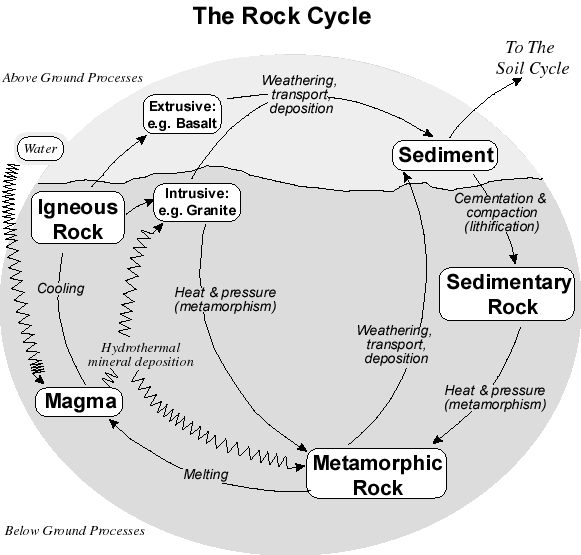7.4: The Rock Cycle
- Page ID
- 2274
One of the primary effects of plate motion is to put new material from deep in the earth’s mantle onto the surface of the earth, and at the same time, destroy old crust. This creation, modification, and destruction of the surface materials of the earth is called the rock cycle. However, before we begin our discussion of the rock cycle, let’s clarify a very important point: rocks and minerals are not the same thing! A mineral is a naturally occurring, inorganic, solid element or compound, with a definite composition or compositional range and a regular internal crystal structure. A rock is a solid, cohesive aggregate of one or more minerals or mineral materials.
The key difference between a rock and a mineral is the ‘regular internal crystal structure’ of a mineral. For example, Quartz is a mineral (SiO2), while Granite is a rock. If you were to look at a quartz crystal at the molecular level, the entire crystal would be made up of identical building blocks (SiO2 molecules). Granite, on the other hand is not homogenous. Therefore, one chunk of a piece of granite, when viewed at the molecular level would appear very different from another chunk viewed at the molecular level because the first chunk might be a quartz crystal, while the second chunk might be another type of crystal.
Rocks are categorized by how they are formed. Rocks that are formed directly from liquid rock, or magma that wells up from deep in the earth are called igneous rocks. Rocks that form at, or just below the surface of the earth from weathered and decomposed bits of other rocks are called sedimentary rocks. Igneous or sedimentary rocks which are subjected to intense pressure or temperature (but not enough to melt them) form metamorphic rocks. A graphic illustration of the rock cycle is provided below.

Igneous Rocks
Igneous rocks are formed from magma (liquid rock) which is pushed up through the earth’s crust. There are two types of igneous rocks. Extrusive igneous rocks are ‘extruded’ onto the surface of the earth through a volcanic eruption where they are rapidly cooled in the air or water of the ocean. The size of crystals in igneous rocks is inversely related to the speed at which the rock cooled. Therefore, extrusive igneous rocks have very small crystals or no crystals at all because they cooled so rapidly. Basalt is a common example of an extrusive igneous rock.
Intrusive igneous rocks are formed when magma is forced just below the surface of the earth. There, it cools very slowly and large (1 cm to 1 m) crystals can form. Over time, the material that covers the intrusive igneous rock wears away, revealing it at the surface. Granite is an example of an intrusive igneous rock. Most of the Sierra Nevada and Cascade mountain ranges are made up of granite.
Sedimentary Rocks
Rocks at the surface of the earth are broken down by weathering processes (more on that in lecture 9) to form sediment. Sediment is a loose term for anything ranging from fist-sized chunks of rock in a stream bed to gravel, sand and mud. Dead organic material is also sediment. Basically, all the unconsolidated material you see at the surface of the earth is sediment.
There are two types of sedimentary rocks. The first is the clastic sedimentary rock. Over time (geologic time) new sediment covers up old sediment, and there is enough pressure on the sediment to lithify it. Lithification is the process of compaction, cementation and hardening of sediments into sedimentary rocks. Clastic sedimentary rocks are composed of fragments of other rocks. They are often stacked in distinct layers with the oldest material on the bottom. An example of a common clastic sedimentary rock is sandstone, such as the sandstone layers of the Grand Canyon.
The second type of sedimentary rock, the chemical sedimentary rock, forms when water seeps through sediments and dissolves certain minerals, then deposits the minerals in a new location. An example of this is deposits of gypsum or halite (table salt) which often form in the desert after rain. Another example of a chemical sedimentary rock is limestone. Limestone is precipitated calcium carbonate (CaCO3). Limestone is the primary component of much of the central United States. One problem with chemical sedimentary rocks is that it is very easy for water to re-dissolve them. Sink holes form where water has dissolved limestone in the ground, forming a cave which then collapses. Sink holes are a common hazard of areas that have thick limestone deposits.
Metamorphic Rocks
Metamorphic rocks form in the earth’s crust from existing sedimentary or igneous rocks. Metamorphic rocks have been subjected to such severe pressures and/or temperatures that the chemical elements that make up the minerals in the rock rearrange themselves to form new minerals. Metamorphic rocks reach the surface the same way that intrusive igneous rocks reach the surface, through uplift, weathering and erosion. Metamorphism (the process that creates metamorphic rocks) also changes the appearance of landscapes. You can often see twisted and folded layers of rocks in metamorphic regions.


